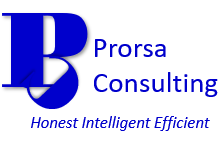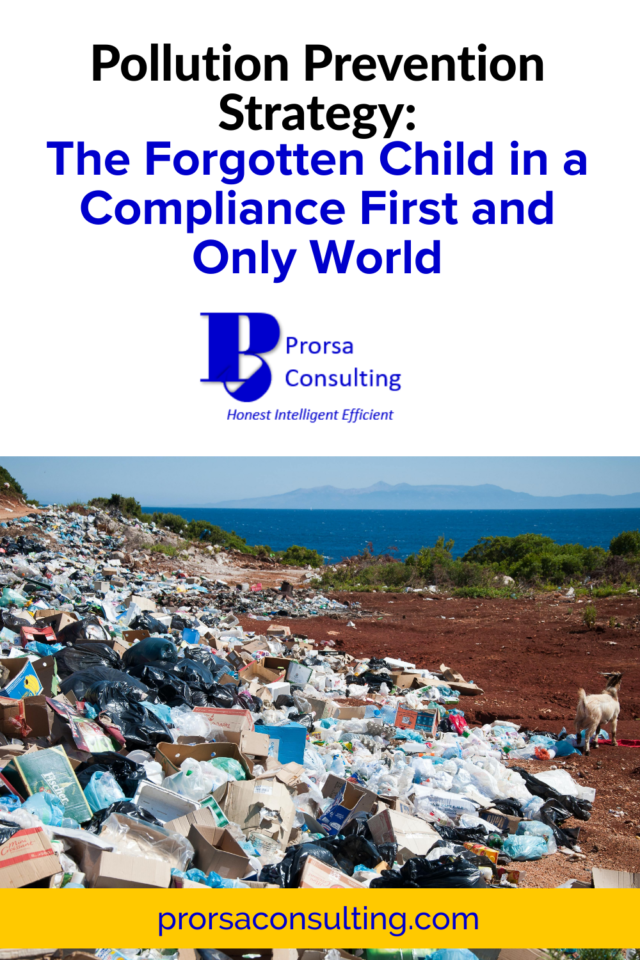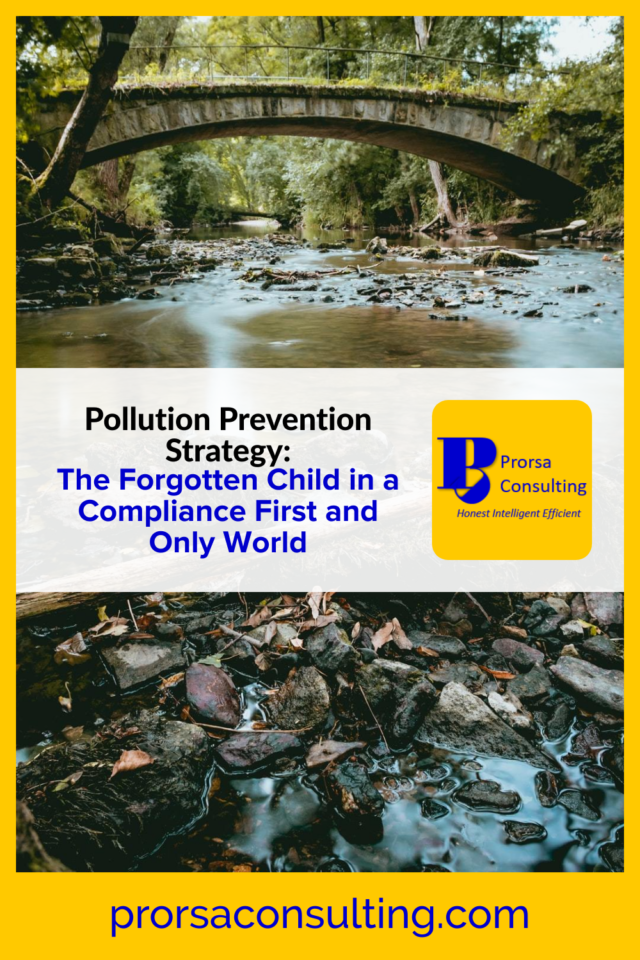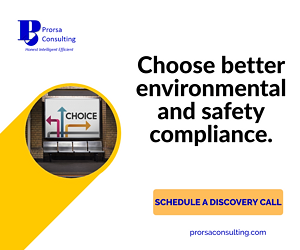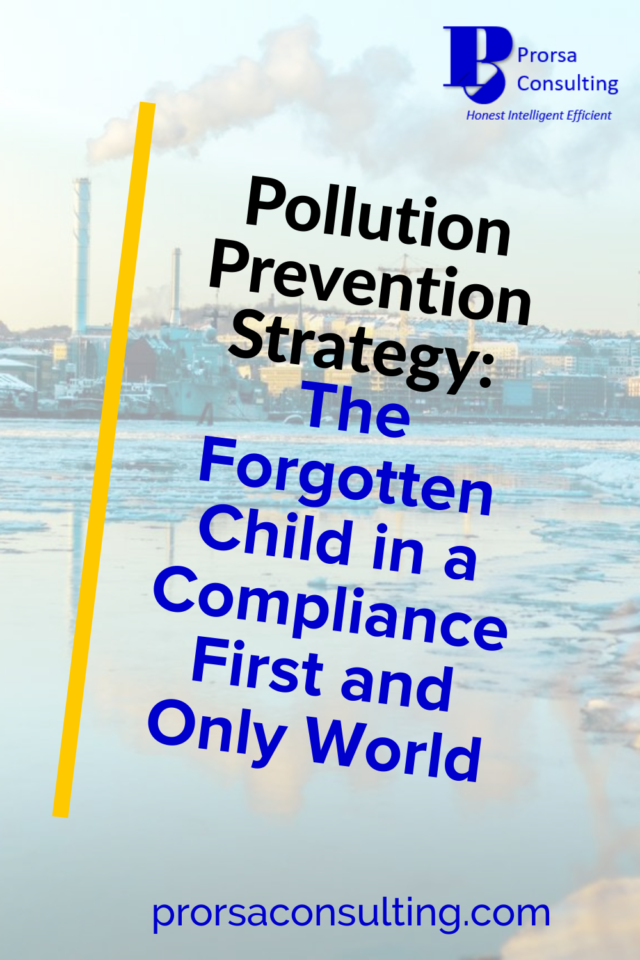Pollution Prevention Strategy: The Forgotten Child in a Compliance First and Only World
By : Admin -
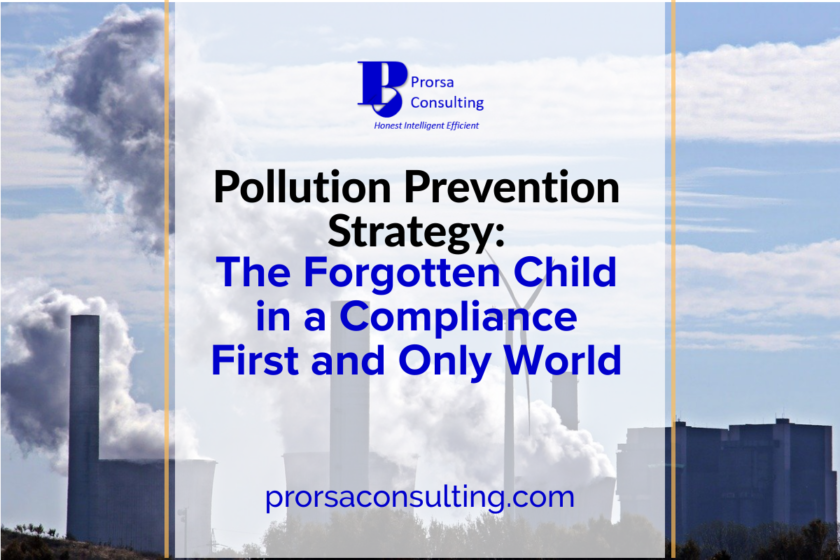
A solid environmental compliance program does not necessarily result in a robust pollution prevention strategy.
Compliance represents only the minimum standard. In essence, being compliant puts you in the mediocre category. Furthermore, environmental compliance focuses heavily on not exceeding pre-established limits. So, companies are allowed to pollute as long as they stay within the thresholds. Does this sound like a firm pollution prevention strategy?
Preventing pollution often requires operations to look and perform beyond just simple compliance. Robust policies to reduce pollution induce organizations to identify and implement solutions to eliminate and decrease pollutants over time.
Unfortunately, too many organizations become content living in the “compliance first and only” world and never step back to examine what this mindset may be costing their businesses. So, let’s look at why and how an organization may start building a better program for the prevention of environmental pollution.
Making a Case for Strong Pollution Prevention Tactics
Pollution prevention’s potential benefits matter both on the larger social scale and personally to the business itself. Thus, before any company decides not to embark on pollution prevention, it should have firm reasoning for its inaction.
The government encourages organizations to prevent pollution.
In 1990, the Pollution Prevention Act, or P2 Act, was signed into law. The U.S. Congress agreed that a national policy of source prevention and reduction, recycling, and environmentally safe treatment should be employed, respectively, before the last resort of pollution disposal.
Furthermore, Congress recognized that current compliance regulations focused on treatment and disposal instead of the cornerstone of pollution prevention . . . source reduction. As such, it expressed the need for the Environmental Protection Agency (EPA) to tackle the historical inattention to source reduction.
The P2 Act does not mandate the development of EPA rules requiring sources to reduce pollution. Instead, the law compels the agency to promote and measure source reduction activities within the industry. It also sets requirements for access to data about pollution prevention methods and activities, training on source reduction opportunities, and annual awards for innovative programs.

Image by Anne Nygard at Unsplash.com.
Strategies to prevent pollution save money.
All companies benefit when they can lower operational costs. Consequently, a strong pollution prevention strategy helps businesses achieve this. Source reduction focuses on stopping pollutants before their introduction to the environment. Fewer pollutants entering the natural ecosystem mean lower emission and release fees paid to the government.
When companies practice upstream source reduction, they decrease the quantity of natural resources they consume. Furthermore, monies saved on raw materials, fuel, electricity, water, etc., can translate easily into a more lucrative bottom line.
Additionally, upstream conservation can translate into less waste downstream of the process. Thus, treatment and disposal costs will decline.
Enhanced environmental performance leads to a better business reputation.
Business reputation can make or break a company. Accordingly, organizations spend considerable financial resources to improve their reputations and win more customers. Companies can help strengthen their brands with excellent environmental stewardship by implementing a stellar pollution prevention strategy.
Businesses may garner less scrutiny from environmental regulators when they are actively reducing pollution. A better relationship with regulatory agencies assists in making dealings over compliance issues much more manageable.
Likewise, a heightened focus on the environment can bring more customers to the table. Market shifts point to consumers’ and business customers’ desires to buy from and work with greener companies. An implemented pollution prevention program could be the deciding factor between winning a customer or having an individual purchase from the competition.

Image by Florida-Guidbook.com at Unsplash.com.
Pollution Prevention Strategy: Source Reduction via Natural Resource Conservation
Natural resource conservation presents the best way to stop pollution before it starts.
An architect named Ludwig Mies van der Rohe popularized in modern culture the phrase, “Less is more.” This sentiment applies to the idea of source reduction. The best pollution prevention scenario involves operating at the same or higher production level while consuming fewer inputs and generating less waste.
Consuming fewer natural resources also makes for more sustainable operations over the long haul. Many resources used today by industries are limited and nonrenewable. So, it only makes for good business to conserve today for tomorrow.
Now, we can look at natural resource conservation for source reduction at two points. Upstream conservation deals with natural resources consumed as inputs to the operations. Downstream prevention addresses the unwanted outputs of the process and the natural resources utilized to treat and dispose of them.
Upstream natural resource conservation starts with examining operational inputs.
When assessing operational inputs, one will naturally gravitate to looking simply at the raw materials needed to create the desired product. However, sound pollution prevention tactics entail investigating beyond the necessary ingredients entering the process to make the company’s widget.
Items like fuel, water, and electricity should be considered in the evaluation, as well. Organizations may start this exercise by asking questions, such as:
- Are there more environmentally-friendly raw materials for my products?
- Can the business procure raw materials with less packaging?
- Do alternative fuel choices exist that would be feasible with the operation?
- Does the company possess the capability to source materials locally?
- Are wind or solar electric power options available to the operation?
- Do company policy and training reinforce personal conservation practices for employees while in the workplace?
Moving to alternative materials and fuels, sourcing locally, using green electricity, and encouraging workers to cut off water taps and electric devices when not in use will make a positive dent in pollution prevention. Yet, source reduction must include a discussion on operational efficiency, which we will cover in a few moments.
Downstream natural resource conservation revolves around giving waste new life.
Let’s get one thing straight . . . Treatment and disposal of waste consume natural resources without a benefit. It takes fuel to transport the unwanted byproducts to a disposal facility. Moreover, treatment may utilize additional raw materials, water, or energy, to decontaminate the waste enough for disposal.
So, establishing other means to address waste on-site helps curtail the consumption of more natural resources, thus generating less pollution. Organizations should assess the feasibility of reworking off-specification products and byproducts into their saleable goods. Also, operations could evaluate whether their waste could serve as raw materials for other facilities.
A pollution prevention strategy of utilizing waste on-site for a secondary purpose could serve as a great alternative solution. If reuse seems impractical, businesses should consider recycling. Items like paper products, plastics, metal, and electronic devices in whole or part can be recycled into other products. All these pollution prevention tactics turn an operation’s trash into treasure.
Pollution Prevention Strategy: Source Reduction Via Operational Efficiency Improvement
Enhancing operational efficiency can get companies to a less is more outcome.
In the last section, we discussed producing the same or more with less. Well, efficiency gains provide the gold standard for achieving this goal.
Efficiency provides a good-faith measure of how well a company utilizes resources to produce its products. In a perfect universe, businesses would be able to create something from nothing with no waste. But we don’t live in that reality, so the discussion around efficiency should be one of incremental improvements in corporate policies to reduce pollution.
As with natural resource conservation, organizations can address efficiency on two fronts . . . process and equipment. Process efficiency addresses how organizations make widgets or supply services. Equipment efficiency speaks to the machinery used within the process.
Optimizing process efficiency serves as a best-in-class pollution prevention strategy with long-term gains.
Process efficiency is not a new concept in the business world. We tend the use the word “synergy” now. Yet, the basic idea is the same.
Examining the operational process for efficiency gains should be completed systematically. Organizations must look for issues with processing steps, material flow patterns, and quality as part of their policies to reduce pollution. These particular operational aspects may utilize resources without contributing positively to the end product. This review should again encompass all inputs to the process, including raw materials, water, fuel, electricity, etc.
For example, a company could be wasting finished product due to loss during excess product transfers. Currently, the organization may need three units of raw material to make every widget sold. By engineering out the extra transfers, the business may find it only actually needs two units of raw material to produce one widget.
Organizations should streamline processes to only the steps required and keep the generation of off-specification products to a minimum. These improvements will help keep the raw materials flowing into the end products and not the waste pile. Reconfiguring shorter material flow paths also assists businesses in reducing the amount of fuel and electricity needed to move materials around the operation.
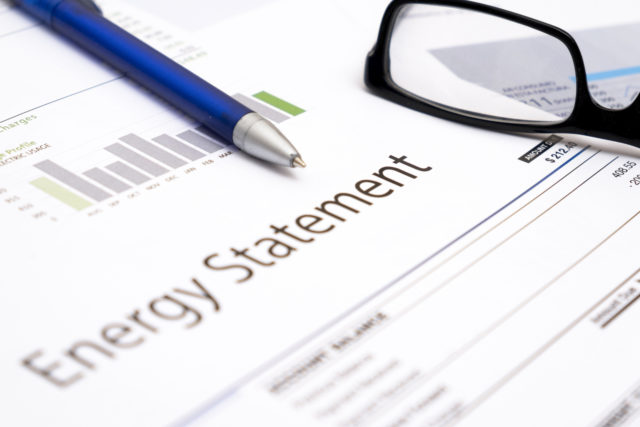
Image by Paolese at Adobe Stock.
Maintaining a reasonable level of equipment efficiency provides a highly viable method for source reduction.
When talking about equipment efficiency, the discussion mainly focuses on maintenance. Think about equipment in the operation as you would your car . . . You know it runs best when in peak operating condition.
Well-maintained equipment will utilize less energy, resulting in lower emissions than machinery in poor repair. Moreover, normally functioning equipment more capably uses raw materials to produce superior quality products. As such, a business should include a robust preventative and corrective maintenance program for its mobile and stationary equipment for the prevention of environmental pollution.
Purchase of new and replacement equipment can also play a role in reducing pollution in the environment. As technology improves, more recent models of equipment often possess better efficiency ratings. While most companies can’t afford to upgrade all their equipment at once, minor upgrades over time can give operations more efficient machinery for the future.
Other Pollution Prevention Posts for You
Simple Ways to Dip Your Toe into Environmental Sustainability in Business Today
Environmental Pollution Prevention Strategies You Should Try Before Treatment
Closing Thoughts
Having a compliance-focused mindset does not automatically translate into an effective pollution prevention strategy. Facilities should look beyond regulatory mandates to consider source reduction, including conservation and efficiency gains, to stop pollution before it starts. Taking this approach can decrease operational costs over the long run while protecting the environment.
We encourage your feedback on this blog. Be sure to like, comment, and share below if you enjoyed the content. You can also provide us with feedback via our Contact Us page.
Don’t forget to follow Prorsa Consulting on LinkedIn, Pinterest, and Twitter.
Prorsa Consulting works with regulated businesses to assess, maintain, and improve environmental and safety compliance to lower business risk. Schedule a discovery call today to start down the path to better compliance.
How would you like access to additional, exclusive EHS updates and info from Prorsa Consulting? All you have to do is sign up for the Prorsa Consulting Newsletter below. You’ll get access to our free resources area and all the tools, templates, and presentations in the library. Get your free subscription today!
